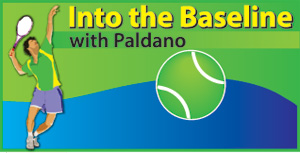Sri Lanka’s Davis Cup of 2023
View(s):
Sorana Cirstea of Romania celebrates after defeating Elena Rybakina of Kazakhstan during their Women's Singles Third Round match
Tennis player development has two mainstream objectives to a nation. One is to help individual players to enter WTA and ATP rankings. The other is team development to participate in Davis Cup, King’s Cup and regional games such as Asian Games and South Asian Games. Into the latter, a nation has to exhibit commitment. This is so in all successful nations in that branch.
Davis Cup since 1950
Davis Cup started by Dwight Davis to bring the interest and input of nations into tennis in 1900. The Wimbledon Championship in England and US Open in New York kindled tennis interest in England and in North America. They are for individual pursuit. Dwight Davis’ move made the whole world play tennis. Today the Davis Cup competition has well over 200 countries. Globally only second to football.
I recall Rupert Ferdinands narrating their journey to play Canada to play our first Davis Cup tie in 1950. At one stage, we were very comfortable in Group II of the Asian Zone and just one match short of promotion from going into Davis Cup Group I. The tie was against Hong Kong in Hong Kong. The team had Umesh Waloopillai, Rohan de Silva and Arjun Fernando.
Of recent, Harshana Godamanne did well and Sri Lanka played Group II. Many countries have this one player issue staling promotions in Davis Cup ladder. Two players in top 200 of the ATP ranking is a requisite for Group II. Good doubles can make big difference to a tie’s outcome. Nothing new to read, nothing done is also nothing new.
Team Development Strategy
An ITF responsibility to lead nations into effective Davis Cup team building methodology. They have failed here in all emerging nations. Primarily because it is a long term plan. There has been no remedial approach from ITF to nations like ours. Many countries in our region face this difficulty. For them Davis Cup Group II, III and IV is a snake and ladder game board for the last three decades. [Dwight Davis will have to walk again to rectify]
Tactical defects of our players
 Our players stand in two metres behind the base line and conduct non-tactical stroke-making repertoire. This allows all court targets open to opponents. With this allowance, opponents went into fearsome attack against our players. Strangely, this never changed even when our players noticed that they are losing. Bankruptcy of tactics?
Our players stand in two metres behind the base line and conduct non-tactical stroke-making repertoire. This allows all court targets open to opponents. With this allowance, opponents went into fearsome attack against our players. Strangely, this never changed even when our players noticed that they are losing. Bankruptcy of tactics?
Our development does not address time based playing tactics within a rally nor possess competency to apply them. Our extremely low all court stroke-making skills is a glaring defect. A development error that will need immediate attention. Overseas players show good development in these and did extremely well.
A possible road
Godamanne went to Thailand for development rather late in his 20s and picked up some good tactical competencies. During his junior phase in Sri Lanka, Godamanne was not the prominent player. Francis Emmauel, Nishendren and a few others were the junior names. Even though late Godamanne corrected his tennis with overseas training. There is a message in this to all of us from Godamanne. Our coaching strategy needs a wakeup call. Even right now, our players do not play in India, our easy access development land for tennis. Forget not, we are an island.
Iran vs Pacific Oceania
Both these teams got the promotion into Group II in Colombo last week. Iran was the second best nation in West Asia for a long period from the 1950s. Watching their tie against Pacific Oceania [there is no nation by that name of Pacific Oceania. An ITF arrangement for players from the Pacific Islands to participate. The nations are Tonga, Vanuatu, Kiribati and Marianna Islands. Almost 95% of these territories is water. Players train in Australia and New Zealand]. The third team promoted last week in Colombo was Vietnam.
Iranians played the class of tennis that could keep them in Group II for the next few years. They possess effective stroke making skills with tactical venom of arrows. None of their shots had the time donating high flights over the net. Their slice, top spin and slat shots skimmed the net giving minimum time. Iranians play positioning around and inside the base line. This denied all of the easy targets to opponents. Their net game was extremely effective. They also knew how to lob and when to lob. Something we should learn from Iranian tennis. Pacific Oceania was pretty much close to the Iranian tennis. They deserve the promotion with Vietnam.
Disturbing feature
The schools big match big band playing in a Davis Cup tie in Colombo is out of place for tennis. A disturbance to concentrate and kills the aura of an earnest Davis Cup spirit. It contributes to our defeats. Have you seen a Wimbledon match with big band? Sri Lanka and Cambodia were relegated to Group IV last week.
– George Paldano, European and Asian competition player; Coach German Tennis Federation; National coach Brunei and
Sri Lanka; Davis Cup, Federation Cup coach, coached ATP, WTA and ITF ranked players in Europe and Asia; WhatsApp +94775448880–


